A development team without the right tools is like a painter without brushes. Regardless of size and industry, businesses favor .NET for diverse software solutions due to its robust cross-platform framework. In ASP.NET, developers can leverage features like opening ASP files, querystring ASP net, and repeaters ASP net for efficient and dynamic data presentation on web pages. ASP.NET Core's flexibility allows developers to build responsive and interactive web applications using repeaters to display data in a repeating pattern, enhancing the user experience.
Specific tools are essential to develop enterprise applications on the .NET platform seamlessly. A proficient code editor is crucial for tasks like writing and debugging code, alongside other tools contributing to the swift creation of custom applications, .NET developers shape the future of ASP.NET, utilizing essential tools for seamless enterprise application development.
This blog will discuss the .Net and .Net core and top 10 dot net tools for your business.
What is .NET and .NET Core?
Software development is rapidly evolving, with new tools and methods constantly emerging. Microsoft's .NET platform has become a standout technology in this landscape, transforming from its origins as a Windows-centric application framework into a comprehensive solution for diverse operating systems and devices.
The latest version, .NET 7, introduces improvements such as native Ahead-of-Time (AOT) compilation, enhanced cryptography, and Garbage Collection (GC) Regions. .NET Core is the successor to the .NET Framework, which offers cross-platform compatibility and an open-source model, distinguishing it from its licensed predecessor.
The .NET Software Development Kit (SDK) provides developers with a complete suite of tools, libraries, and compilers for building and running applications. With .NET Core, developers can create applications spanning desktops, mobile devices, the web, and the cloud.
Microsoft's decision to drop the 'Core' designation with the release of .NET 5 signifies its consolidation into a singular platform. Additionally, ASP.NET Core, a web framework built on .NET Core, has gained prominence for developing websites and web applications, offering a unified approach for web app and API development. This makes ASP.NET development a key component of the broader .NET ecosystem. Furthermore, ASP.NET Core provides features like ASP.NET custom validator for custom validation scenarios, ASP.NET core web API, ASP.NET 5 angular js, and ASP.NET web service for building robust APIs.
As per Statista, the enduring popularity of the .NET platform, with over 30% of developers utilizing it. This success can be attributed to. NET's cross-platform capabilities allow developers to create enterprise applications that are compatible with number of operating systems and devices.

The .NET platform remains a prominent player in software development, providing a flexible and expansive environment supported by various tools and frameworks.
Top 10 .Net tools for your business
Here is the list of essential add-ons in the Dot NET tools that are beneficial for developing .NET applications.
1. Visual Studio
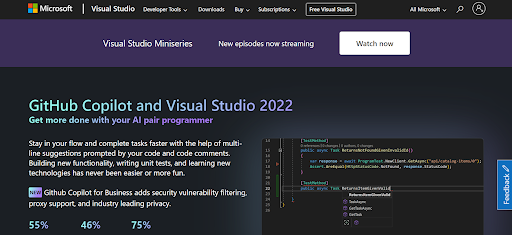
Visual Studio Code (VS Code) has emerged as a preferred choice among developers, commanding a usage rate exceeding 70%, as evidenced by the graph illustrating the popularity of various code editors and IDEs.
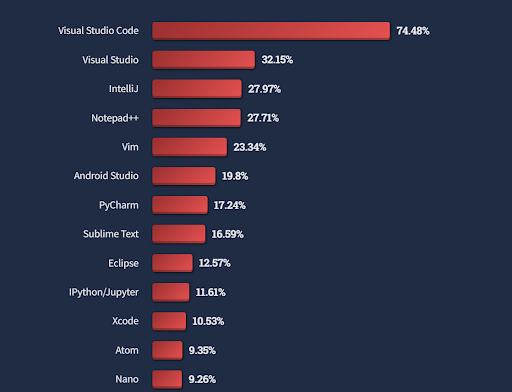
The versatility of VS Code extends beyond its application in .NET development, encompassing robust support for an array of programming languages and frameworks. Its capabilities encompass languages like C#, C++, and Visual Basic and compatibility with essential runtimes such as .NET and Unity.
Developed by Microsoft, Visual Studio Code is a comprehensive code editor characterized by a suite of built-in features. Its inclusivity across Windows, Linux, and macOS platforms ensures widespread accessibility. Beyond serving as a code editor, it functions as a builder and debugger, offering users the flexibility of seamless customization and integrating third-party extensions to augment functionality.
Key Features of Visual Studio Code:
- Cross-platform compatibility (Windows, Linux, macOS)
- Holistic capabilities as a code editor, builder, and debugger
- Tailored customization options with support for third-party extensions
- Inherent support for JavaScript, JSON, HTML, CSS, and JSX
- Specific features catering to native, web, and language-specific technologies
2. Chocolatey
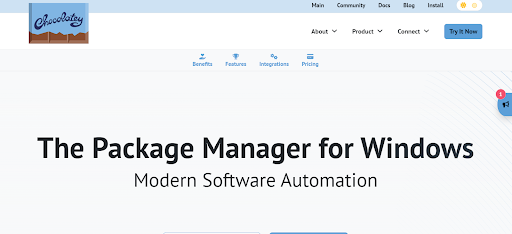
In developing custom applications with .NET, dealing with multiple software packages and programs manually is a time-consuming challenge. To simplify this process, developers often opt for automation tools like Chocolatey.
Chocolatey makes installing, uninstalling, and updating programs and packages a breeze, eliminating the need for manual configurations and compatibility checks for .NET applications on Windows systems. It also excels in creating packages, making it a versatile tool for software management.
An impressive feature of Chocolatey is its ability to handle software across various environments- in the cloud, on-premises systems, or Docker containers, all achieved with a single command. This tool effectively manages the complete software lifecycle, from installation to updates and removals, seamlessly integrating with NuGet for .NET package management.
A .NET developer job description may emphasize the importance of skills related to automation tools like Chocolatey, as they are key in optimizing the development and management of .NET applications in various environments.
Key Features of Chocolatey:
- It efficiently packages applications, installers, zip files, and script files.
- Chocolatey employs Windows PowerShell for various functions, enhancing its effectiveness.
- Chocolatey allows for the internal hosting of packages, offering a centralized repository for easy access.
- The tool easily integrates with other tools, boosting its versatility and compatibility.
- It provides central management capabilities, enabling users to access information from different endpoints.
- Its compatibility with PowerShell modules enhances the tool's extensibility, further expanding its functionality.
3. NuGet
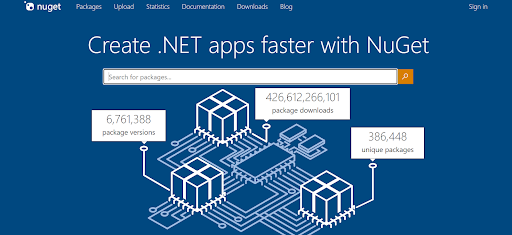
Within the domain of .NET development, the judicious selection and integration of software packages are pivotal to ensuring a streamlined project workflow. At the core of this process lies the significance of proficient package management, a facet indispensably facilitated by dedicated package managers.
For the realm of .NET development, Microsoft's NuGet package manager emerges as a cornerstone tool. It utilizes the Dot NET CLI to simplify and enhance packages' installation, removal, and updating procedures across diverse operating systems, including Windows, Linux, and macOS.
NuGet provides the requisite functionalities for efficient package consumption, creation, and publication within a professional development environment.
Key Features of NuGet:
- NuGet offers an intuitive interface, offering developers a seamless experience handling package installation, removal, and overall management.
- A notable feature of NuGet is its embedded Package Manager Console, which augments command-line capabilities and further streamlines package management processes.
- NuGet integrates with the MSBuild toolchain, allowing developers to create and restore packages seamlessly within their projects.
- It offers developers an exhaustive suite of tools encompassing package consumption, creation, and publication.
4. LINQPad
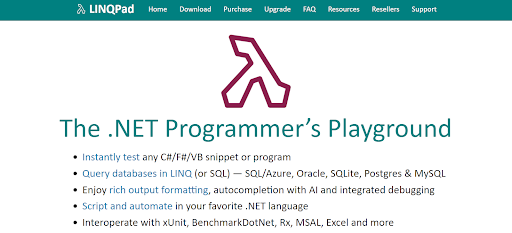
The versatility of the Dot NET SDK in application development is undeniable, encompassing a wide range of use cases. Integral to this process is the need for thorough code testing and efficient database querying. LINQPad emerges as a pivotal tool in Dot NET enterprise application development, allowing developers to test code snippets, execute programs, and query databases using SQL or LINQ.
This lightweight .NET tool boasts a mere 20MB executable file, delivering a streamlined experience. LINQPad excels in generating typed database contexts through its built-in optimized engine. These contexts facilitate the transformation of SQL data into C# objects, simplifying developers' interactions with diverse databases.
Key Features of LINQPad:
- LINQPad provides visually appealing and informative output presentations.
- The tool offers automatic suggestions while typing, enhancing coding efficiency.
- Developers have the choice to use a debugger for troubleshooting and identifying issues.
- LINQPad supports dynamic development, providing immediate feedback on code changes.
- Developers can test code blocks or programs in F#, C#, or VB, allowing flexibility in language choice.
- LINQPad's built-in engine generates typed database contexts, simplifying the interaction between SQL data and C# objects.
- The tool supports various database drivers, including SQLite, SQL Server, SQL Azure, Oracle, MySQL, and PostgreSQL.
- LINQPad is versatile for various use cases in Dot NET enterprise application development.
5. ReSharper
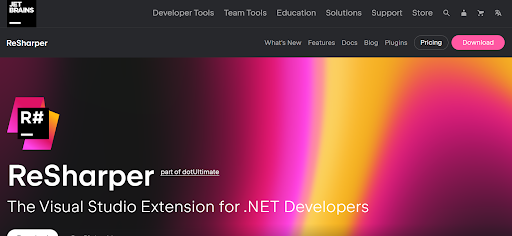
ReSharper is a popular tool among Dot NET developers and is a helpful extension for Microsoft Visual Studio. It is crafted to make coding in .NET easier and quicker by checking and improving your code.
This tool is like an intelligent developer assistant—it spots issues in your code and can even fix them automatically. It's pretty good at catching and preventing potential problems in your code. Thanks to its automated code refactoring, ReSharper simplifies changing your code without messing up how it works.
Key Features of ReSharper:
- Code analysis for the identification of issues and prompt application of fixes to enhance code quality.
- Robust refactoring capabilities that enable modifications to the codebase without impacting its behavior or functionality.
- Streamlined solution traversal, allowing easy navigation to various elements such as types, files, and type members.
- Code editing assistance, including auto-importing namespaces, code rearrangement, and other transformative features.
- Provision of language-specific settings and configurations to uphold and enforce code standards.
6. NDepend
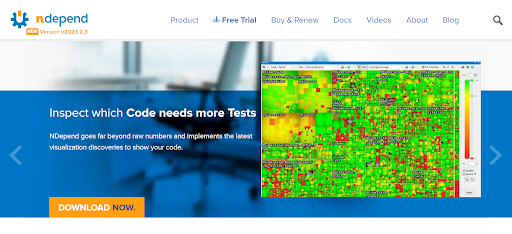
NDepend is a handy tool for .NET developers and teams looking to improve their code without causing disruptions. It works on Windows, macOS, and Linux, supporting frameworks like .NET, .NET Core, ASP .NET Core, and more.
It comes as a Visual Studio Code extension, presenting code metrics in a user-friendly visual format, making it easy for developers to optimize and assess code quality.
Key features of NDepend:
- Keeps an eye on recent code changes, spotting issues like code smells and rule violations to maintain code quality.
- Specializes in estimating and preventing technical debt, ensuring proactive code quality management.
- Sets up a "Quality Gate" to enforce quality standards before making changes or releasing code.
- Generates detailed reports for a deep dive into your code.
- Uses visual tools to create logical pictures and graphics for better code understanding.
- Works swiftly to provide a seamless code analysis experience.
7. dotMemory
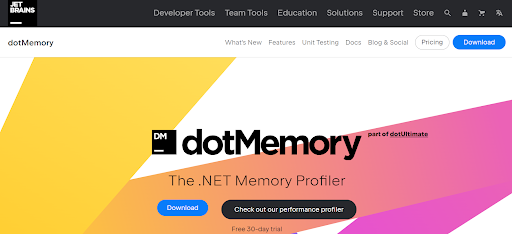
While several differences exist between the .NET framework and .NET Core, developers often utilize standard tools for application development in both technologies. One tool is dotMemory, a memory profiler for .NET and .NET Core applications.
DotMemory proves invaluable for Dot NET developers, providing insights into the memory usage of their software. It aids in identifying and addressing memory leaks, ultimately optimizing performance and ensuring efficient memory utilization. Through dotMemory, developers can thoroughly analyze the memory consumption of both .NET and .NET Core applications to enhance memory efficiency.
Key features of dotMemory:
- Real-time display of application memory consumption in an intuitive timeline view.
- A convenient one-click option to capture screenshots during profiling sessions without disrupting the ongoing process.
- Instant detection of common memory issues through a user-friendly single-click feature supported by built-in inspections.
- The flexibility to apply various criteria to software memory usage data allows developers to scrutinize it from different perspectives.
- Detailed traffic analysis within specific timelines to comprehensively understand application memory behavior.
8. dotTrace
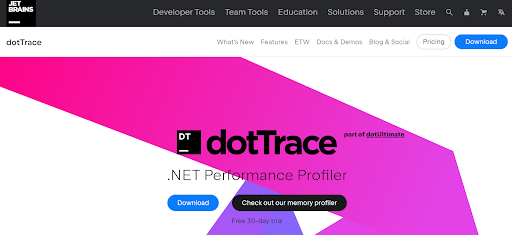
DotTrace functions as a performance profiling utility, providing developers with a visual assessment of an application's performance and offering strategies for improvement. Notably, it sheds light on the utilization of CPU and memory resources.
Key features of dotTrace:
- A thorough analysis of all performance issues.
- Profiling of HTTP requests and SQL queries, offering a comprehensive performance overview.
- Profiling of unit tests and static methods for a detailed examination.
- The capability to profile and analyze call stacks directly within the integrated development environment (IDE).
9. NCrunch
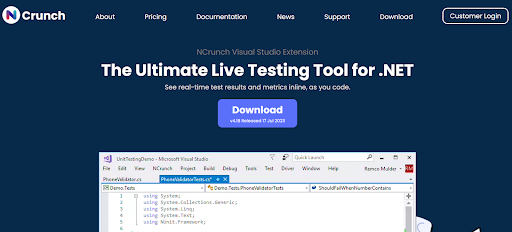
NCrunch is a dependable testing utility tailored for .NET developers, providing dynamic testing capabilities for .NET applications. NCrunch streamlines the testing process with various features, including live unit testing, making it a valuable developer asset.
As an automated tool seamlessly integrated with Microsoft Visual Studio, NCrunch enables real-time code monitoring and displays test outcomes through markers embedded alongside the code.
Key features of NCrunch:
- Presentation of code performance data.
- Capability to execute multiple tests concurrently.
- Prioritization of recent code modifications.
- Ongoing tracking of code coverage in real-time.
- In summary, NCrunch elevates the testing experience by delivering a feature-rich environment that facilitates efficient and effective testing for .NET applications.
10. Postman
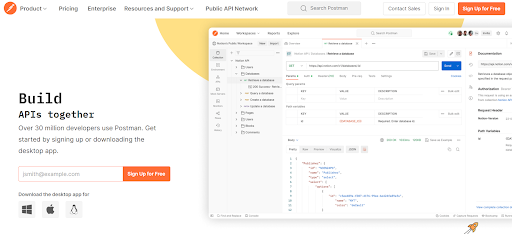
Postman is an Indian-origin company that provides developers with a collaborative platform for testing APIs. It establishes an efficient testing environment for HTTP requests, accommodating local and remote API testing. While its core functionalities include executing basic REST calls and organizing requests into folders for various services or APIs, Postman extends its utility with various advanced features.
Key Features of Postman:
- Postman goes beyond basic testing by offering multiple automated testing options, streamlining the testing process, and ensuring comprehensive API coverage.
- Developers can utilize environment variables in Postman to manage and customize their testing environments efficiently.
- Postman provides a command-line interface, empowering developers to easily integrate testing into their workflows.
Final Words
.NET is one of the most widely utilized software development frameworks, catering to various applications across various platforms. Developers like .NET, .NET Core, and ASP .NET can create applications for desktops, mobile devices, and the web with its offerings. The selection of appropriate .NET tools is crucial, considering factors like performance, cost, project objectives, and learning curve.
Additionally, Comparing the .NET framework vs core and ASP.NET vs VB.NET is significant for web development using the .NET platform. Understanding the differences is crucial for making informed decisions about the technology stack for web applications.
Furthermore, exploring an ASP.NET Bootstrap tutorial can be immensely beneficial for improving web development capabilities. Integrating Bootstrap, a popular front-end framework, with ASP.NET allows for the creating of responsive and visually appealing web applications. Such tutorials provide valuable insights into what is a .asp file and leverage the synergy between ASP.NET and Bootstrap, enabling developers to craft modern and user-friendly interfaces for their projects.
For expert Dot NET and Dot NET Core development, consider For expert .NET and .NET Core development, it is essential to consider reputable .NET development companies like Saffron Tech. With a proven track record in various projects, we specialize in delivering successful applications. Contact us to discuss your requirements and leverage our expertise in .NET development.
Subscribe to Saffron Tech
Explore your marketing zen with our newsletter! Subscribe now.




